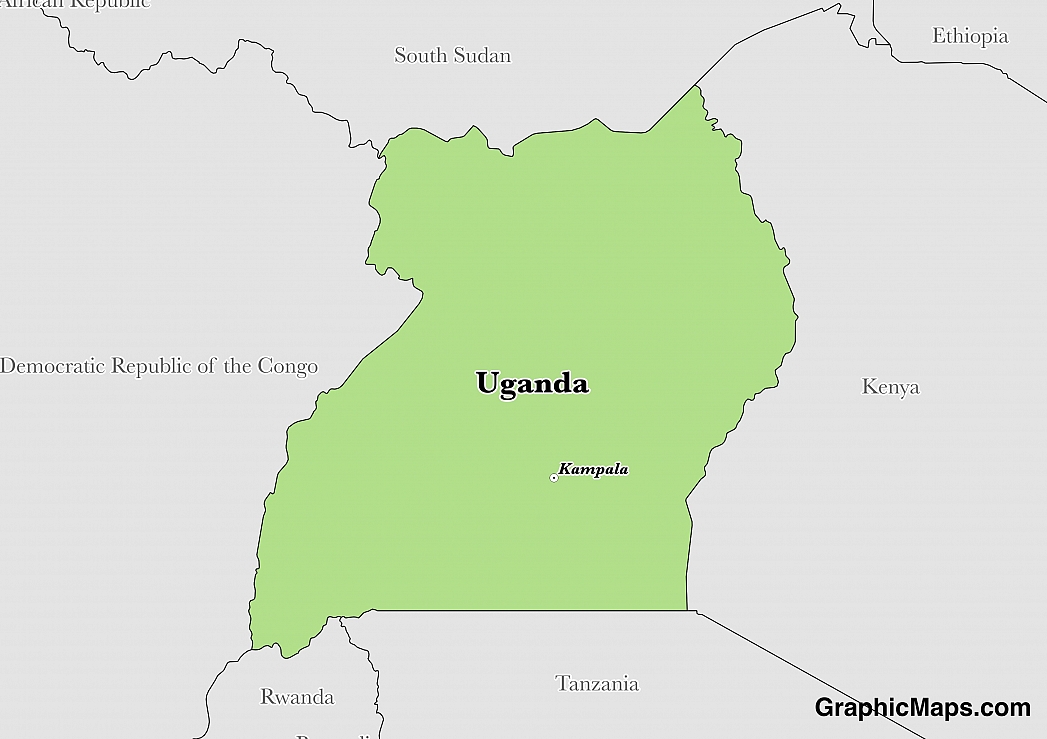Where is Uganda?
Located in East-Central Africa, Uganda has a 2,729.00 km border with Democratic Republic of the Congo (877 km), Kenya (814 km), Rwanda (172 km), South Sudan (475 km) and Tanzania (391 km). Uganda is subject to armed fighting among hostile ethnic groups, rebels, armed gangs, militias, and various government foces.
The capital of Uganda is Kampala, which is located along the south central border of this country. The oldest neighborhoods in this city were built throughout 7 hills in the area. Today, however, its size has increased beyond these original hills. With a metropolitan population size of over 2 million, Kampala is the most populated city in Uganda. The individuals living here represent a diverse group of tribes and ethnicities. This city is a relatively popular tourist attraction in this country and offers a number of historic and cultural sites as well as outdoor activities. Kampala was officially designated as the capital of Uganda in 1962, when the country gained independence. It is located in the tropical rainforest climatic zone.
Read more on Uganda's CapitalUganda is an African country covering 241,038.00 km2 of which 18.23% is water and 197,100.00 km2 is land. This makes it the 79th largest country in the world and slightly more than two times the size of Pennsylvania; slightly smaller than Oregon. Its geographic coordinates are 1 00 N, 32 00 E and Kampala is the capital city.
The country's name comes from the Swahili "Buganda".
Its ISO code is UG.
Geography
Uganda has a mean elevation of 0 m above sea level.
It has a temperate continental climate that is Mediterranean on the southern Crimean coast; otherwise temperatures vary greatly by region. Its terrain is mostly made up of plateaus with some mountain coverage.
Population
Uganda has a population of 38,319,241 making it the 35th largest in the world.
English is the official national language, and Ganda or Luganda is also widely spoken. The most common ethnic groups reported are Baganda, Banyankole, and Basoga. The majority of the population is Protestant Christian or Roman Catholic.
Swahili and English and the two officially recognized languages of Uganda. Swahili belongs to the Bantu subgroup of the Niger-Congo language family, while English is a West Germanic tongue of the Indo-European language family. Both language are written with the Latin alphabet, although Swahili can also be written in the Arabic script. Of the 34.85 million individuals living in Uganda, approximately 34.114 million speak Swahili. Only 313,000 of these individuals, however, claim it as a native language. English, primarily used by the government, is the second language of around 2.5 million individuals. One of the most widely spoken minority languages in this country is Ganda, the native language of around 5.56 million individuals, most of whom live in the Buganda kingdom.
Read more on Uganda's LanguagesThe dialing code for the country is 256.
Government
Uganda is an independent country. It gained independence from the United Kingdom in 1962. Its constitution was last ratified in 1995.
The government of Uganda is carried out under a presidential republic framework, which means that the citizens of the country elect individuals to representative their political interests. The President leads Uganda, acting as both the Head of Government and the Head of State. The legislative branch is represented by the National Assembly, a unicameral parliamentary body with 426 representatives. The judicial branch of government acts independently. The citizens of Uganda elect the President and the members of the National Assembly to serve for a 5-year term. This term, at least in the case of the President, is renewable. The current President, for example, has held office since 1986. Legislative representatives are elected from 238 constituencies. Some seats are reserved for special populations and interests; 110 positions must be filled by women and an additional 38 positions are reserved for other special interest groups.
Read more on Uganda's GovernmentEconomy
Factoring in Purchasing Power Parity, Uganda's GDP is $84,930,000,000.00 (USD) with $2,100.00 (USD) per capita. This makes it the 91st largest economy and its citizens the 195th richest in the world. The currency of Uganda is the Shilling (UGX).
Its major export partners are Rwanda, the United Arab Emirates, and the Democratic Republic of the Congo. Its main exports are coffee, fish and fish products, and tea. Its major import partners are Kenya, the United Arab Emirates, and India. Its major imports include capital equipment, vehicles, and petroleum.
Flag
Uganda officially adopted the national flag on October 9, 1962, which corresponds to its official date of independence. The flag of Uganda is characterized by 6 alternating and horizontal stripes of equal measurement. The first 3 stripes are black, yellow, and red (from top to bottom) and this pattern is repeated on the second half of the flag. A solid white circle with a grey crowned crane is located in the center of the flag, overlapping the two center stripes. Each color on the flag has a specific meaning and the crowned crane is considered the national symbol of the country. The flag of Uganda was designed by the Uganda People’s Congress political party after it won the majority rule in April of 1962.
Read more on Uganda's FlagThis page was last modified on January 17th, 2018
More on Graphicmaps

Published on 2019-11-06
What is a Trade Embargo?

Published on 2019-11-04
Which Two Countries Used to Have the Same Flag?

Published on 2019-09-16
What Is the Only Two-Sided State Flag?

Published on 2019-09-16
Which Country Flag Looks Like the Texas Flag?

Published on 2019-08-29
Flags That Resemble the US Flag

Published on 2019-08-20
